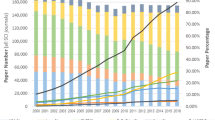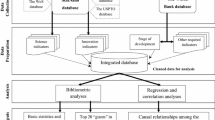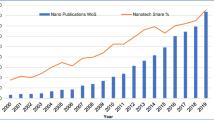Abstract
In a relatively short interval for an emerging technology, nanotechnology has made a significant economic impact in numerous sectors including semiconductor manufacturing, catalysts, medicine, agriculture, and energy production. A part of the United States (US) government investment in basic research has been realized in the last two decades through the National Science Foundation (NSF), beginning with the nanoparticle research initiative in 1991 and continuing with support from the National Nanotechnology Initiative after fiscal year 2001. This paper has two main goals: (a) present a longitudinal analysis of the global nanotechnology development as reflected in the United States Patent and Trade Office (USPTO) patents and Web of Science (WoS) publications in nanoscale science and engineering (NSE) for the interval 1991–2012; and (b) identify the effect of basic research funded by NSF on both indicators. The interval has been separated into three parts for comparison purposes: 1991–2000, 2001–2010, and 2011–2012. The global trends of patents and scientific publications are presented. Bibliometric analysis, topic analysis, and citation network analysis methods are used to rank countries, institutions, technology subfields, and inventors contributing to nanotechnology development. We then, examined how these entities were affected by NSF funding and how they evolved over the past two decades. Results show that dedicated NSF funding used to support nanotechnology R&D was followed by an increased number of relevant patents and scientific publications, a greater diversity of technology topics, and a significant increase of citations. The NSF played important roles in the inventor community and served as a major contributor to numerous nanotechnology subfields.








Similar content being viewed by others
Notes
We use here the National Nanotechnology Initiative definition (http://www.nano.gov).
US Patent and Trademark Office, “Performance and Accountability Report, fiscal year 2012.” Accessed 14 February 2013 at http://www.uspto.gov/about/stratplan/ar/USPTOFY2012PAR.pdf.
US Patent and Trademark Office, “All Technologies Report, January 1, 1987 – December 31, 2011,” March 2012. Accessed 14 February 2013 at http://www.uspto.gov/web/offices/ac/ido/oeip/taf/all_tech.pdf.
National Science Foundation, “About Awards.” Accessed 21 February 2013 at http://www.nsf.gov/awards/about.jsp.
References
Adams JD, Griliches Z (1998) Research productivity in a system of universities. Ann Econ Stat 49(50):127–162
Beise M, Stahl H (1999) Public research and industrial innovations in Germany. Res Policy 28(4):397–422
Brin S, Page L (1998) The anatomy of a large-scale hypertextual Web search engine. Comput Netw ISDN Syst 30(1):107–117
Chen H, Roco MC, Son J (2013) Nanotechnology public funding and impact analysis: a tale of two decades (1991–2010). IEEE Nanotechnol 7(1):9–14
Criscuolo P (2006) The home advantage effect and patent families. A comparison of OECD triadic patents, the USPTO and the EPO. Scientometrics 66(1):123–141
Dang Y, Chen H, Zhang Y, Roco MC (2009) Knowledge sharing and diffusion patterns. IEEE Nanotechnol Mag 3(3):16–21
Fazayeli F, Wang L, Mandziuk J (2008) Feature selection based on the rough set theory and expectation–maximization clustering algorithm. Rough sets and current trends in computing. In: 6th International conference, RSCTC 2008, Akron, OH, USA, 23–25 Oct 2008. Springer, Berlin
Huang Z, Chen H, Yan L, Roco MC (2005) Longitudinal nanotechnology development (1991–2002): national science foundation funding and its impact on patents. J Nanopart Res 7(4):343–376
Igami M, Okazaki T (2007) Capturing nanotechnology’s current state of development via analysis of patents. OECD science, technology and industry working papers, 2007/4. OECD Publishing, Paris Cedex
King J (1987) A review of bibliometric and other science indicators and their role in research evaluation. J Inf Sci 13(5):261–276
Kulkarni AV, Aziz B, Shams I, Busse JW (2009) Comparisons of citations in Web of Science, Scopus, and Google Scholar for articles published in general medical journals. JAMA 302(10):1092–1096
Li X, Lin Y, Chen H, Roco MC (2007) Worldwide nanotechnology development: a comparative study of USPTO, EPO, and JPO patents (1976–2004). J Nanopart Res 9(6):977–1002
Liu T, Liu S, Chen Z, Ma W (2003) An evaluation on feature selection for text clustering. In: Proceedings of the international conference on machine learning, Atlanta
Narin F (1998) Patents and publicly funded research. Assessing the value of research in the chemical sciences. National Academy Press, Washington, DC
Ordonez C, Cereghini P (2000) SQLEM: fast clustering in SQL using the EM algorithm. ACM SIGMOD Record. ACM, Dallas
Payne AA, Siow A (2003) Does federal research funding increase university research output? Adv Econ Anal Policy 3(1): Article 1
Piekkola H (2007) Public funding of R&D and growth: firm-level evidence from Finland. Econ Innov New Technol 16(3):195–210
Roco MC (2000) Nanotechnology research directions. Kluwer, Dordrecht
Sastry K, Rashmi H, Rao N (2010) Nanotechnology patents as R&D indicators for disease management strategies in agriculture. J Intellect Prop Rights 15:197–205
Surdeanu M, Turmo J, Ageno A (2005) A hybrid unsupervised approach for document clustering. Proceedings of the eleventh ACM SIGKDD international conference on knowledge discovery in data mining. ACM, Paris
Toole AA (2012) The impact of public basic research on industrial innovation: evidence from the pharmaceutical industry. Res Policy 41(1):1–12
Wang J, Shapira P (2011) Funding acknowledgement analysis: an enhanced tool to investigate research sponsorship impacts: the case of nanotechnology. Scientometrics 87(3):563–586
Acknowledgments
This study was supported in part by the National Science Foundation (CMMI-1249210). The second co-author was supported by the National Science Foundation Directorate of Engineering. Research data was made available through Thomson-Reuters’ Web of Science.
Author information
Authors and Affiliations
Corresponding author
Rights and permissions
About this article
Cite this article
Chen, H., Roco, M.C., Son, J. et al. Global nanotechnology development from 1991 to 2012: patents, scientific publications, and effect of NSF funding. J Nanopart Res 15, 1951 (2013). https://doi.org/10.1007/s11051-013-1951-4
Received:
Accepted:
Published:
DOI: https://doi.org/10.1007/s11051-013-1951-4




